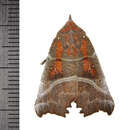Conservation Status
fourni par University of Alberta Museums
An uncommon but very widespread species; no concerns.
- licence
- cc-by-nc
- droit d’auteur
- University of Alberta Museums
Cyclicity
fourni par University of Alberta Museums
Adults fly in Alberta from late March through early October, with a gap in July. Adults hibernate.
- licence
- cc-by-nc
- droit d’auteur
- University of Alberta Museums
Distribution
fourni par University of Alberta Museums
Holarctic; in North America from NFLD to Vancouver Island, south to northern Mexico. Throughout the wooded areas of Alberta.
- licence
- cc-by-nc
- droit d’auteur
- University of Alberta Museums
General Description
fourni par University of Alberta Museums
Unmistakable. A medium-size (3.8-4.3 cm wingspan) orange-brown moth with falcate and strongly scalloped forewings. The forewing is crossed by a faint antemedian and prominent, slightly curved, doubled pale postmedian line. A broad brighter orange basal streak expands into the median area. The hindwings are dull orange-brown. Antennae of males are bipectinate. Scoliopteryx belongs to the Noctuid subfamily Catocalinae.
- licence
- cc-by-nc
- droit d’auteur
- University of Alberta Museums
Habitat
fourni par University of Alberta Museums
Wooded areas.
- licence
- cc-by-nc
- droit d’auteur
- University of Alberta Museums
Life Cycle
fourni par University of Alberta Museums
The Herald emerges from the pupae in late summer or early fall, then hibernates. Hibernating adults may be found in barns and other buildings, and numbers have been found in limestone caves in Manitoba. The adults re-appear in spring and lay eggs. The larvae, which are solitary defoliators on willow and poplars, are bright green with a yellow dorsal stripe. The larvae pupate in summer, in a slight cocoon between leaves of the host-plant. Adults are nocturnal and come to both light and sugar bait. The larva is illustrated in Ives and Wong (1988) as well as with adults on a number of websites
- licence
- cc-by-nc
- droit d’auteur
- University of Alberta Museums
Trophic Strategy
fourni par University of Alberta Museums
Mainly willow of many species (Salix spp.), also poplar (Populus sp.) (Prentice, 1962).
- licence
- cc-by-nc
- droit d’auteur
- University of Alberta Museums

